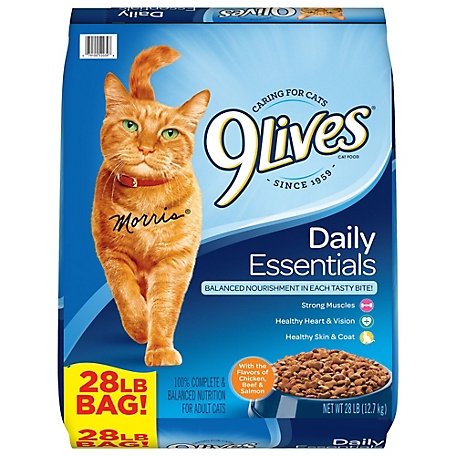9Lives Daily Essentials All Life Stages Chicken, Beef and Salmon Formula Dry Cat Food
Give your cat the flavors of salmon, chicken, and beef with 9Lives Daily Essentials cat food. Our delicious formula helps support heart health, clear vision, strong muscles, and healthy skin and coat. It’s the great taste they want with the balanced nutrition they need to help provide a long, healthy life.
Give your cat the flavors of salmon, chicken, and beef with 9Lives Daily Essentials cat food. Our delicious formula helps support heart health, clear vision, strong muscles, and healthy skin and coat. It’s the great taste they want with the balanced nutrition they need to help provide a long, healthy life.
- 100% complete and balanced nutrition for all cat life stages
- High quality protein helps support strong muscle growth
- Omega 3 fatty acids help promote healthy skin and coat
- Taurine helps maintain heart and vision health
Additional information
| Country of Origin | Made in USA |
|---|---|
| Breed Size | Extra Small, Small, Medium, Large, Extra Large |
| Flavor | Chicken, Beef and Salmon |
| Health Features | Muscle Health, Heart Health, Vision Health, Skin & Coat Health |
| Indoor/Outdoor | Indoor and Outdoor |
| Life Stage | All Life Stages |
| Primary Flavor | Chicken, Beef, Salmon |
| Special Diets | AAFCO Formulated |
| Warranty | 1 Year |
| Packaged Height | 25 in. |
| Packaged Length | 5.75 in. |
| Packaged Width | 17.5 in. |
| Manufacturer Part Number | 7910052039 |












by Lee
my cats eat it tried the cheap stuff and they waste it so I spent more for something they would eat.
by Tyson
Garage cats love it.
by Frank
We use this for our feral cats and they love it.
by Angela
Nice that they had it in stock. It has been hard to get the bigger bags.
by Cathy
My cats have been eating Friskies for as long as I’ve had cats which is over 40 years. My friend gave me 9 lives because her kitty passed away. Well, my cats went nuts over it. They are now 9 lives dry food eaters, all 6 of them! They still prefer the Friskies canned food but not the dry food.